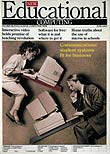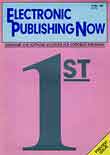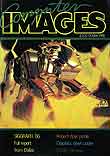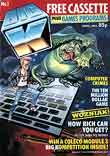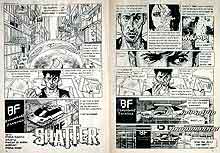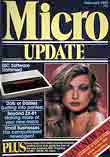Magazine launches & events 1975-1989
Magazines listed by cover date with most recent at top. Also with alphabetic links to magazines on the right. Launches in other years.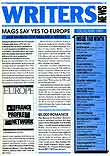 Writers News saw potential in Europe and the booming area of wordprocessing |
Writers NewsOctober 1989. David & Charles Publishing. 40 pp.Ed: Richard Bell The advent of cheap wordprocessing on computers such as the BBC Micro and the Amstrad PCW encouraged writers. |
 Fourth issue of the Time Out spin-off 20/20 with Batman on the cover |
20/20April 1989. Time Out. £1.50; 180 pp. Ed: Don AtyeoNational critical guide to arts events, mainly in the shape of film and music. Marlon Brando was on the cover of the launch issue (he'd just pulled out of Donald Cammell's Performance) and there were pieces on Peter Greenaway, Pet Shop Boys, Alan Parker and John Waters. Each issue carried a column by Julie Burchill, who reviewed films before she'd seen them. Batman was on the cover of the fourth issue of this short-lived spin-off from Time Out (Sell-Out was another). Description of the editor: 'Don Atyeo was a blunt Australian of scabrous good humour who could out-Kelvin MacKenzie' by later Time Out editor Dominic Wells in the British Journalism Review (2006, issue 3). |
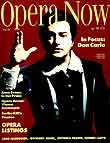 Opera Now put Dennis O'Neill on the cover as Don Carlo from Verdi's grand work |
Opera NowApril 1989. Opera Now Enterprises. £2; 108 pp. Ed: Mel CooperThe launch issue cover article highlighted an 11-page main feature, with Antonia Fraser, Lord Harewood and others addressing the history and issues raised by Don Carlo. Music magazines A to Z |
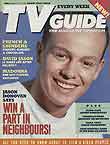 TV
Guide was Rupert Murdoch's attempt to break
into weekly TV listings in the UK as a European ruling forced Radio
Times and TV Times to relinquish their monopoly on programme
listings TV
Guide was Rupert Murdoch's attempt to break
into weekly TV listings in the UK as a European ruling forced Radio
Times and TV Times to relinquish their monopoly on programme
listings |
TV Guide25 March 1989. Murdoch Magazines, London. 40p; 60pp. Ed: Ian Birch Rupert Murdoch's interest in the sector was based on a move in the US and the fact that the UK duopoly for TV listings held by Radio Times and TV Times was to be broken up. In 1988, News International had bought Triangle Publications, which owned TV Guide, the market leader in the US selling 17m copies a week (it was founded in 1952). The company decided to bring the concept to the UK, with managing director Liz Rees-Jones announcing in January 1989 that it intended to launch a title to take advantage of the breaking up of the listings monopoly. This was triggered by a European Commission ruling. Several other publishers, including Emap, were also planning launches – in fact 'a flood' of launches was expected in the sector. Media Week (6 January 1989) reported: 'The Commission's ruling relates to a complaint by Irish publishers Magill, which had tried to publish a weekly TV guide in competition with TV Times and Radio Times – which circulate widely in the Republic. The Commission has ruled that TV and Radio Times' tight rein on schedule information was contrary to Article 86 of the EC Treaty. This ruling will now have to be considered by the UK Government, which is bound by the Treaty.' However, when TV Guide launched it could only carry details of cable and satellite listings – the terrestrial pages were merely summaries of the week's 'essential viewing'. Murdoch had to wait for legislation to break the monopoly held by Radio Times and TV Times. In December, Murdoch raised the guaranteed circulation of TV Guide by 30,000 to 150,000 copies a week. It was selling 190,335 copies a week at the time. However, in the same month, the company signalled a U-turn by deciding to turn the title into a subscriptions-based monthly for satellite TV alone in March 1990 when the duopoly on terrestrial TV listings lifted. A tough economic climate, Rupert Murdoch's debts and the £50,000 charge by Independent Television Publications for its listings put paid to the ambitious plans. In fact, recession set in, interest rates rose and the debt from the US Triangle deal nearly sank Murdoch. He sold off most of his magazine assets in the US and the UK. See TV Choice |
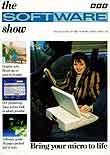 Carol Vorderman on the front cover of The Software Show magazine |
The Software ShowSpring 1989. BBC/Redwood Publishing, London. Free supplement with
Acorn User. 52pp. Group ed: Tony Quinn; ed: Geoff Bains.
|
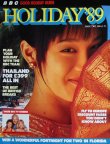 |
BBC Holiday '89Spring 1989. Issue 2 shown. Redwood/BBC Enterprises. £1.75; 100 pp perfect bound. Ed: Juliet Walker'BBC Good Holiday guide'. Precursor to BBC Holidays in 1992 under Ramune Burns BBC Magazines profile Holidays and travel magazines |
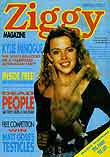 Ziggy set up Kylie Minogue as its first target: 'The dog's bollocks or a talentless Australian tart?' |
Ziggy1989 (publication date unclear). Big Mags, West Drayton, Middx; £1;
48 pages. Editor: Stuart Blair |
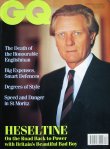 Tory politician and founder of Haymarket Publishing Michael Heseltine on the cover of the first issue of GQ in the UK |
GQDecember/Jan 1989. Conde Nast, London.Paul Keers launches long-established US men's title (Gentlemen's Quarterly) in UK. Tory politician and founder of Haymarket Publishing Michael Heseltine on the cover Conde Nast profile Men's magazines history |
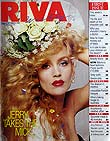 Model Jerry Hall was on the cover for Carlton's £7.5 million launch |
Riva13 September-25 October 1988. Carlton / IPC, weekly. Ed: Sally O'SullivanCarlton's Riva aimed to have 'the pace of a weekly with the gloss of a monthly'. Cost 50p and first issue had model Jerry Hall (Mick Jagger's girlfriend) on cover. At £7.5 million, the launch budget was then the largest in Britain. (Bauer's weekly Bella had cost £5m the previous year.) Riva was part of a response by Carlton and IPC owner Reed to incursions in the previous year – Marie Claire to compete with Elle and Vogue at the top end of the fashion market; Essentials, a practical monthly up against Prima; and Riva facing Best and Hello!. IPC profile Issue breakdown |
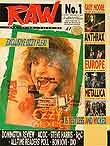 Rogue Magazines' Raw was bought by Emap within 7 months of its launch. The first issue carried an Ozzy Osbourne flexi disc cover mount |
Raw (Rock Action Worldwide)31 August-13 September 1988. Fortnightly. Rogue Magazines, 3a Kendall
Place, London W1. £1. Stapled. 60pp. The associate publisher was former pop star Jonathan King, shown dressed in a schoolboy costume playing a guitar. In 2001, King was jailed for four indecent assaults and two serious sexual offences on boys aged 14 and 15. He served half of the seven-year term. In April 1989, Emap bought the title, which claimed a circulation of
up to 35,000. Sales rumbled along at 25,00-30,000 but the title always
trailed behind Emap's weekly Kerrang (which it had bought when
United Consumer Magazines was closed by the Express newspapers group
in 1991). In 1995, Emap took Raw off the shelves for several
weeks and relaunched it
in October with a sample issue free with monthly Select. The
aim was to base the title on pictures and news to complement Emap's Select an
additional, more frequent, read. However, it closed
within five months. |
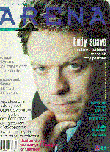 |
ArenaSummer/Autumn 1988. Wagadon |
 At home with Princess Margaret – a classic cover for Hello! (issue 28) |
Hello!17 May. Weekly. 75p. Ed: Maggie Goodman Hello! marked the opening of a new niche, seeing itself as 'The only Good News weekly' witth an escapist format and its subjects giving aproval of the photographs. "We are bought as a treat,' Maggie Goodman told the Independent, 'like a box of chocolates.' The magazine was part of a trend for European publishers to expand into the UK ahead of the country's entry into the European Community. It was printed in Madrid but with the last editorial being flown out on Thursday afternoon to be on sale in the UK the following Tuesday. |
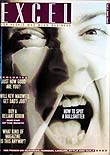 The coverline 'How to spot a bullshitter' led to advertising for Excel being banned |
ExcelApril 1988. White Line Publishing. Ed: Rod Fountain |
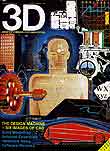 The advent of the Apple Macintosh and Postscript software drove the launch of titles such as 3D |
3DApril 1988. Emap, London. Controlled circulation;56pp. Ed: Chris Cunningham Subtitle: desktop, design, communication. With advertiser response card and survey to register for free copies Emap profile |
 More! - launch issue  More! – 16-page fashion extra with the first issue. Centre spread was a double gatefold. The two parts of the magazine came in a plastic folder |
More!6 April 1988 (fortnightly). Emap London Lifestyle, fortnightly. 55p; 64pp + 12-page fashion fold-out section + 24-page separate fashion sectionWomen's lifestyle/fashion title for 16- to 24-years-olds. The target reader was single and at university or working and living at home. More on Women's glossies A to Z Emap profile |
 Lord Young was the cover subject for this contract publishing title by Fitzroy for Computerland |
ComputerlandJan/Feb 1988. Free contract title for Computerland by Fitzroy. 34pp. Ed: David HewsonA contract magazine for Computerland Europe, a franchise distributor of microcomputers, by PR group Fitzroy. Cover story based on an interview with Lord Young, the minister who headed up the trade & industry department under Margaret Thatcher. DTP was a theme throughout the issue, with the contents page even crediting SMS 19" SuperMac monitors, Quark XPress and an Agfa S200PC scanner used in the magazine's production (by Tony Tyler). |
 M&S Magazine - dummy issue. Felicity Green was editor of the 1.3 million print run contract title |
M&S MagazineNovember 1987. Redwood Publishing. Contract title for Marks and Spencer. Free/£1. Ed: Felicity GreenM&S Magazine was launched with a free circulation of a million copies to the retailer's charge-card holders, with hopes of selling another 300,000 copies in its shops for £1. Campaign described it as 'the 'biggest threat of the decade to upmarket women's titles' and said 'Good Housekeeping, Women's Journal and Options are watching the launch closely' (25 May 1984, p5). It was estimated that two-thirds of ABC1 women aged 25-44 shopped at M&S at least once a month and the magazine followed customer magazine-catalogues from Harrods, Habitat and Laura Ashley. The editor was Felicity Green, who had worked on the Daily Mirror, Express (where Redwood co-founder Chris Ward had been editor) and Working Woman and was an editorial consultant for the Telegraph. Redwood art director Mike Lackersteen, who had been at Good Housekeeping, led the design team. |
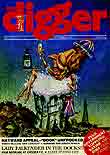 The Digger got off to a good start with 15 pages of advertising in a 40-page first issue, but closed down within a year |
The Digger9 October 1987. General Publications. 55p. 40pp. Ed & publisher:
John Mulcahy |
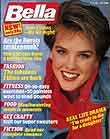 Bella was based on US title Woman's World |
BellaOctober 5, 1987. H. Bauer. 29p;52pp.Ed: Dennis Neeld Bella was Bauer's British version of US title Woman's World. LHS Brompton ran a mail drop promotion whereby 2 million copies were put through doors, mainly in London. It was estimated that three weeks after the launch, Bauer was printing 1.2m copies and selling about 680,000 of them. The launches of titles by both Gruner and Jahr (Prima and Best) and Bauer were marked by the strategy of establishing copy sales before advertising. This was a well established method in Germany, but new to the UK. G&J was willing in to spend up to £10m on Prima before getting any return. Prima was launched with only 12 pages of advertising out of a total of 140 pages, but had 204 pages by autumn 1987, almost half of which were advertising. |
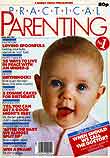 Practical Parenting took market leadership from Argus under IPC |
Practical ParentingApril/May 1987. Family Circle/International Thomson, London.
80p; 100pp. Ed: Davina Lloyd The high birth rate at
the time led to a boom in such titles. The Argus group was the sector
leader with Mother, Mother & Baby and Parents,
but IPC wrested control. |
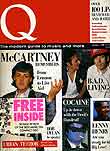 Q first
issue with Paul McCartney as the main feature Q first
issue with Paul McCartney as the main feature |
QOctober 1986. Emap Metro, London. £1.10; 100pp. Ed: Mark Ellen; ed dir: David Hepworth; art dir: Andy Cowles'Magazines tend to bracket people by taste, or what they assume that taste to be,' said Ellen in the first issue. 'This is a magazine that doesn't. but still brings you a wide range of news, comment, interviews and insight. We don't presume to know what you like but we hope you like this.' A tip-on cover sticker promoted a 56-page
CD review booklet that was tipped on to a bound-in subscription
card |
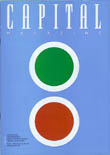 Dummy issue for Capital Magazine, which was to be handed out at rail stations in London |
Capital Magazine26 June 1986. Capital Week Ltd, London. Ed: Lottie WeychanCapital was an attempt to launch a weekly title for London's commuters. It was to be handed out to homebound travellers at British Rail stations in central London, and make its revenue through advertising sales. The distribution figure was 150,000 copies. The dummy issue shown here was made up of two identical 16-page sections that were stapled together with a cover. The publisher was Sally Cartwright and the advertisement director Stephen Hart. Cartwright had been publisher of Ideal Home and Woman's Journal at IPC and went on to become managing director of Harmsworth Publications (Associated Newspapers) in 1988 and then publishing director of Hello! in 1990. |
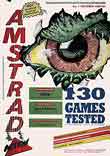 Amstrad Action – a keyboard is reflected in the monster's eye |
Amstrad ActionOctober 1985. Future, Somerton, Somerset. £1; 100pp. Ed: Peter
Connor. Pub: Chris Anderson |
 'The best in country style' was offered by the first issue of Good Housekeeping's Country Living |
Country LivingSummer 1985. National Magazines. £1. 160+4pp. |
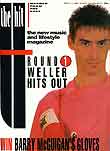 The
Hit billed itself as 'Harder than the rest' with Style Council's Paul
Weller on the cover holding a pair of boxing gloves The
Hit billed itself as 'Harder than the rest' with Style Council's Paul
Weller on the cover holding a pair of boxing gloves |
The HitIPC/Holborn Publishing Group. 45p; 64pp. Ed: Phil McNeill; deputy Paul Du Noyer.The Hit billed itself as 'Harder than the rest' and featured a competition to win a pair of WBA world featherweight champion Barry McGuigan's gloves. It also carried a covermounted 4-track vinyl EP: Style Council, Jesus and Mary Chain, Redskins and Simply Red More at Music magazines history |
 Max Headroom on the front of City Limits |
Max Headroom on City Limits24-30 May 1985. London Voice Ltd. 60p; 92 pp.Eds: John Fordham & Nigel Fountain The Max Headroom Show was a Channel 4 TV series based on a supposedly computer-generated character (the name was inspired by the sign on a car park in London's Soho). The character was created by George Stone, Annabel Jankel and Rocky Morton and played by Matt Frewer. Max fronted the series presenting music videos. Jankel and Morton also wrote a book on computer graphics around the same time Time Out profile |
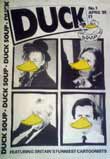 Duck Soup – tabloid paper that was folded in half to show A4 cover for newsagents' shelves |
Duck SoupApril 1985. Duck Soup Pubs, London. £1; 32pp. Eds: Tom Johnston and David Austin.Tabloid newsprint cartoon title. A3 format folded to A4 to fit newsagents' shelves. |
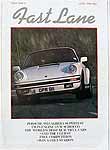 Fast Lane – the first issue with a Porsche 911 Carrera supertest on the cover |
Fast LaneApril 1984. Business Press International (IPC). 116pp + gatefold cover. 90p. Ed: Peter Dron (ex-Motor). Porsche 911 Carrera supertest on the cover with 6 pages inside. BMW M635 (4 pages); VW Golf GTi pitted against Nissan Cherry Turbo, Vauxhall Astra GTE and Ford Escort XR3i (6 pages). Other coverage: 360bhp twin-engined VW Scirocco, BMW K100, BMW 318i , Toyota Corolla GT Coupe, Audi 200 Turbo, Renault 25IPC profile |
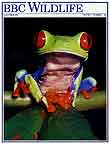 BBC Wildlife – bringing the red-eyed tree frog Agalychnis callidryas to national fame 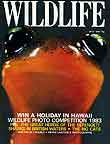 Wildlife before the BBC's relaunch, with a salamander, Ensatina eschscholtzii, on its cover |
BBC WildlifeNovember 1983. BBC Publications and Wildlife Publications, Bristol; £1; 56 pages. Editor: Rosamund Kidman CoxThe cover touted this as 'volume 1 number 1', but this was not a new publication. It was the BBC's relaunch of Wildlife, a title that had begun life in 1963 as Animals with a television presenter, Armand Dennis, as editor. By 1983 it was run by Wildlife Publications Ltd, in London's Great Portland St. The corporation retained many of the staff, including the editor. The sub-A4 format was also retained but the price rose from 75p. BBC Wildlife joined the Radio Times and The Listener in the BBC's publications division, which was part of BBC Enterprises.Kidman Cox stayed as editor until 2004 when the BBC put the magazine under
the control of its Origin Publishing division, which it had recently bought. She
carried on judging the Wildlife Photographer of the Year Competition. |
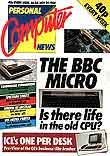 Personal Computer News – issue 88 of the weekly from Nov 24 1984 |
Personal Computer NewsMarch 1983. VNU. Ed: Cyndy Miles. Publisher: Felix DennisWeekly consumer title covering all the then-incompatible home computers such as Sinclair Spectrum, BBC Micro and Commodore 64 Dennis profile |
Your Computer invents cover discDecember 1982. IPC, London; 60p;164 pages. Editor: Toby WolpeAt at time when computer discs were unknown outside the world of mainframes, micro owners typed listings in by hand. With this plastic disc, played at 33.3 rpm, computer programs could be input as binary sounds. Disc held games for the Sinclair ZX81 IPC profile |
 TV Choice was closed by legal action over listings copyright |
TV ChoiceNovember 1982. 25pTV programme guide launched by Mr Michael Storey with an initial print run of 100,000. The publishers had to give temporary High Court undertakings that the magazine would not contain material copied without authority from BBC or ITV schedules. However, TV Choice was forced to suspend publication in January 1983 after both ITV Publications and BBC Publications alleged that the magazine had breached their copyright. Time Out still pressed ahead with a campaign to publish listings in the face of legal action from the BBC and ITV. A title with the same name was launched in Bauer in 1999.IPC profile |
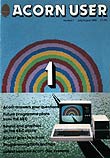 Acorn User one of the many machine-specific titles that thrived in the 1980s. It eventually closed in 2005 |
Acorn UserJuly 1982- spring 2005. Addison-Wesley/Redwood/BBC/Europress. Editor: Tony Quinn |
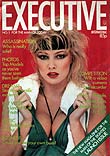 The cover girl was Janine Andrews for Executive's first issue |
ExecutiveMay 1982. Fragilion, London; 85p; 100 pp. Ed: Brian Keogh.'For the man of today.' Playboy-style magazine Men's magazines history Men's magazines A to Z |
 Rupert Murdoch's Sky debut issue front cover with Nick Kamen and Charlotte Lewis |
Sky23 April 1982 (fortnightly). News International and Hachette. 65p; 86pp (numbered). Ed: Ian Birch. Design consultant: Malcolm GarrettNick Kamen and Charlotte Lewis were on the fold-out debut cover of this ambitious fortnightly. The whole issue was a very complex production task:
More at Men's magazines history |
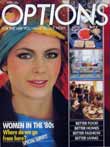 Options debut issue front cover |
OptionsApril 1982. Created and produced by Carlton Publishing; copyright IPC. 236 pp; 60p. Ed: Penny Radford.Women's monthly with the selling line 'For your way you want to live now.' The spine copy read: 'Better food/better homes/better fashion/better living'. Articles included Warren Beatty profile; Shirley Williams interview; and columns by Simon Hoggart and Libby Purves. Details at Women's magazines A to Z |
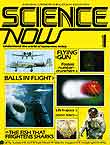 Science Now part work |
Science Now (part work)1982. Marshall Cavendish, London. 75p; 40pp plus an A2 poster (later issues 32pp).A weekly part work from the UK's biggest publisher in the sector. |
 Interiors – the first issue; it was later bought by Conde Nast to become World of Interiors |
InteriorsNovember 1981. Pharos Publications, Chelsea, London. £1.50; 208pp. Editor-in-chief: Min Hogg;Publisher: Kevin Kelly Kevin Kelly set up Interiors and by 1983 it was half owned by Condé Nast and had changed its name to World of Interiors. In April that year, the magazine ran TV advertising, with spots on Channel Four alongside repeats of Brideshead Revisited. The magazine had increased its circulation from 40,500 to 43,436 with 5,000 more copies going to the US. In 1984, World of Interiors was voted consumer magazine of the year and Min Hogg editor of the year. Wendy Harrop, art director, was runner-up in the design section. In December, Harrop was appointed editor and creative director. In 1985, Kelly persuaded Condé Nast and the Financial Times to join with him in launching Business magazine. In 1988, Kelly sold his interest (20%) in the two titles to Condé Nast. This was because of his success in bringing US title W to the UK as a fortnightly. It was selling 40,000 copies under editor Jane Procter within 18 months of its launch (Queensgate Publications). Hogg stepped down from World of Interiors in 2001, to be replaced by her deputy Rupert Thomas. By then it was selling 65,000 copies a month. |
 Kicks mixed music with fashion. Bow Wow Wow's Annabella Lwin was on the cover |
KicksNovember 1981. Teenage Kicks, London.
50p; 48pp Ed: Bert MacIver; design: Andy Dark. |
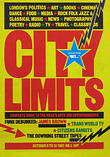 City Limits first issue cover in David King's constructivist style. The copy in the blue star says 'Incorporating "NOT..."', a news sheet the staff had put out while on strike at Time Out  'Psycho' Tebbit in action 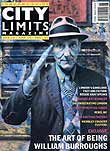 A late City Limits cover with a photograph of US writer William Burroughs from 12 April 1990 |
City LimitsOctober 9-15 1981. London Voice Ltd, 313 Upper Street, Islington, London N1. Distributed by New Statesman. 40p. 92pp. Ed: John FordhamCity Limits was launched by many of the former staff of Time Out (referred to, in a Private-Eyeish way as Another London Magazine) who had left during a protracted dispute after owner Tony Elliot ended the system of equal pay for all staff. During the dispute, Time Out staff had produced a protest news sheet called Not Time Out and this is referred to in the blue star on the front cover of the first City Limits, which says 'Incorporating "NOT...".' The launch issue's editorial states: 'Six months, innumerable dismissals, several writs, threats, recriminations, sit-ins, lock-outs and undignified rumbles later, we have brought you City Limits – a paper that we think you'll agree was worth the fight.' Cartoonist Steve Bell's Maggie's Farm switched from Time Out with the first outing in City Limits portraying Norman Tebbit ripping off an interviewer's head on Maggie's order 'Get him Psycho!' Art director Carol Warren employed design consultant David King to establish an immediately recognisable cover style on a low budget. Christopher Wilson interviewed King for a 2003 issue of Eye and described his work so: 'His graphic style – an easily recognisable mix of explosive sans serif typography, solid planes of vivid colour and emphatic rules – reworked for the New Left in Britain the graphic language of the Russian Constructivists.' Jeremy Leslie's book Issues: New Magazine Design features a spread of City Limits covers. King had a unique collection of Soviet imagery. The collection was acquitted by the Tate museum in 2016. City Limits folded in the early 1990s.Time Out profile Exhibition with City Limits and Time Out covers |
 Not ... (Time Out) issues 17 (September 11) and 18 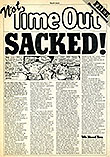 |
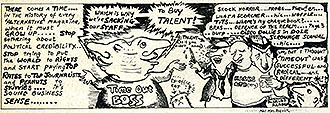
Not ... (Time Out)April-October 1981.
The Greater London Council under left-wing leader Ken Livingstone funded the title. So it was ironic that the launch of City Limits was made possible by legislation brought in by the Thatcher government (from issue 18):
City Limits was expected to have a turnover of £1.25 million in its first year. Time Out profile |
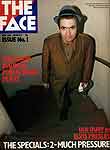 The Face first issue cover |
The FaceSeptember 1980. Feet First Productions for Wagadon. 60p. 64pp. Ed: Nick Logan. Design: Feet First & Steve Bush Inc. Printed by Seven Valley PressJerry Dammers of the Specials was the first issue cover subject for The Face. The photo was taken by Chalkie Davies The Face profile |
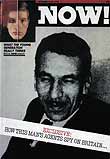 Now! was a British news weekly funded by James Goldsmith |
Now!14-20 September 1979. Cavenham Communications, London. 50p; 144pp. Ed: Anthony ShrimsleyJames Goldsmith was behind this attempt to create a European-facing British news weekly. It closed after about 2 years News magazines history |
 The UK's first magazine for microcomputer enthusiasts – in the days when you built your own |
Personal Computer WorldApril 197UK's first micro magazine. The title was closed down in spring 2009. Computer magazine history |
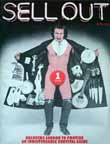 Sell Out first issue cover. It was a spin-off from the London listings magazine Time Out |
Sell OutApril 1975. Best Brands Ltd, 374 Gray's Inn Rd, London WC1X 8BB. 40p; 68pp; A4 format. Ed: Janet Street-Porter; publisher: Tony ElliottSpin-off from Time Out's Sell Out section, which listed bargains and carried consumer information. Marketed as 'an indispensable survival guide.' The cover used spot red but all the other pages were in mono on uncoated paper. The cover matter was a thin card. All the listings in the magazine were free. The editor was Janet Street-Porter – Elliott's wife till 1978 – who was later to make her name on radio and television and, in 1999, as editor of the Independent on Sunday newspaper. In 2002 she became the paper's editor-at-large and writes a column. Time Out profile |
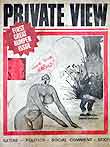 Private View first issue cover. The red box shows a face (possibly Sullivan?) shouting 'Nice one Harold!' as a pipe-smoking fisherman (prime minister Harold Wilson?) hooks the bikini bottoms off the bathing woman |
Private ViewMarch 1974. Roafield Publishing, Godwin Rd, Forest Gate, London E7. Published by David Sullivan. Edited by Miss Doreen Millington; assistant editor Paul Cufley; advertising by Charles Green. 32pp. No price.Private View modelled itself, at least visually, on Private Eye, but its agenda was attacking pornography laws, the police and the way the press reported on adult book dealers. The publisher was David Sullivan, one of the biggest porn barons in Britain and boyfriend of porn actress Mary Millington. (In 2010, Sullivan bought a half stake in West Ham FC, the ground being 2 miles away from the Forest Gate house were Private View was published). In the editorial, Doreen Millington states she has just launched a campaign to legalise pornography in her other title, Private Magazine (published from the same address). Such campaigning is also the theme of Private View. The cover summarises the contents as: ‘Satire, Politics, Social Comment, Sexy!'The first feature, by Doreen Millington [later Whitehouse editor], is a diatribe against the press: 'I am fed up with the way the national press treat the adult book dealers – we all know that they use SEX to sell their papers; yet they refer to adult book dealers as 'Merchants of Menace', 'Porn pushers', etc.'The article goes on to detail the fate of her friends who had been prosecuted for conspiracy to produce obscene articles and what a waste of police resources such action was. Mary Millington committed suicide in 1979, an act was partly blamed on continual police raids on her sex shops. The distributor was Walton Press (Sales), 7 Grenville Rd, London N19. |



